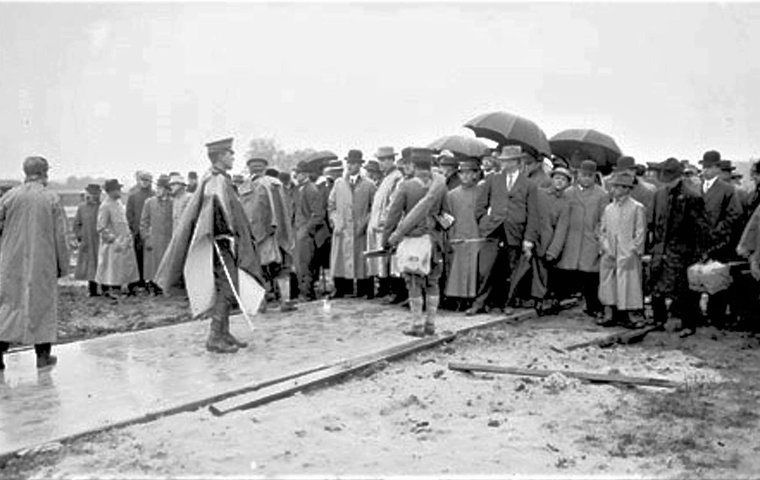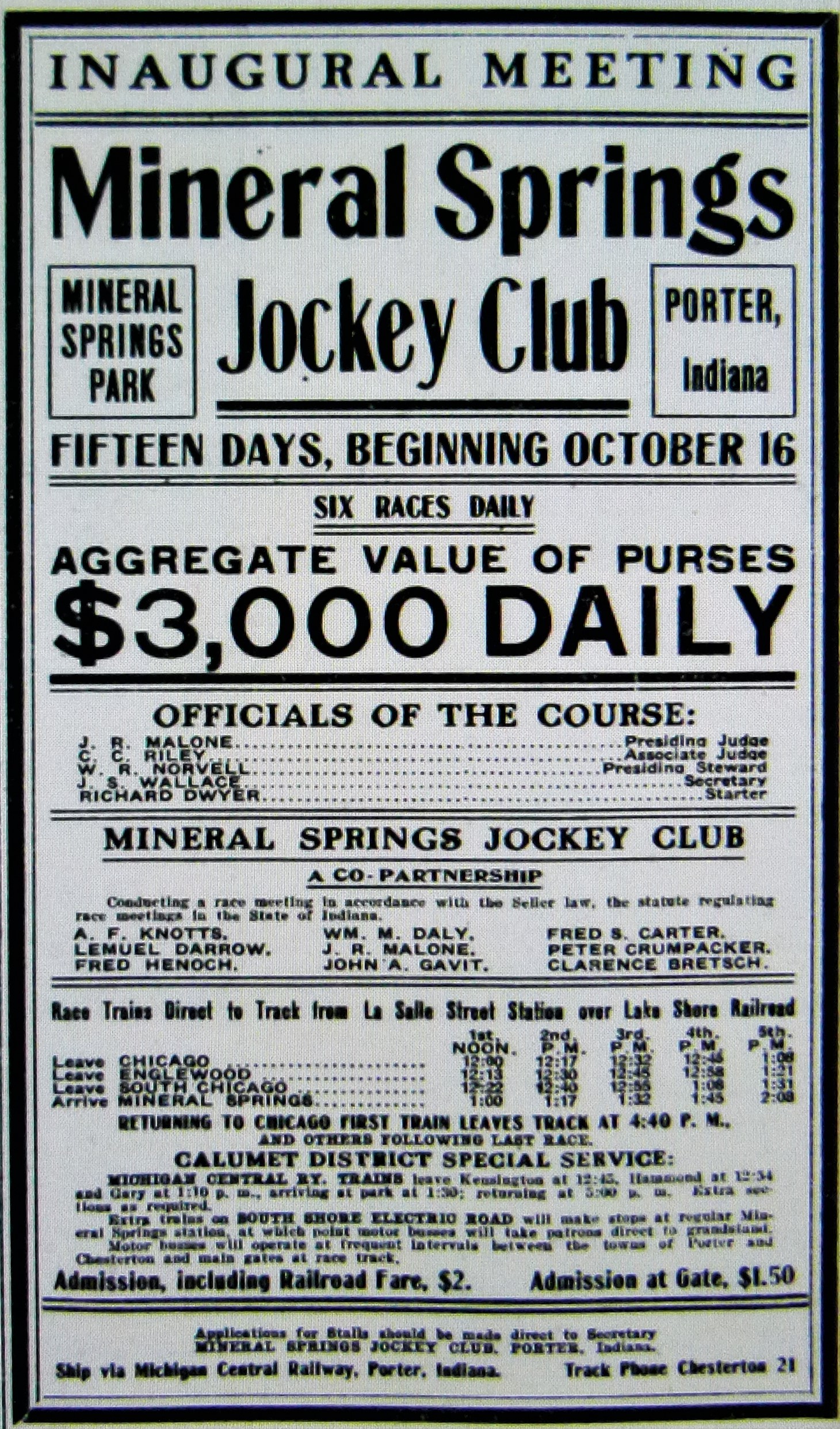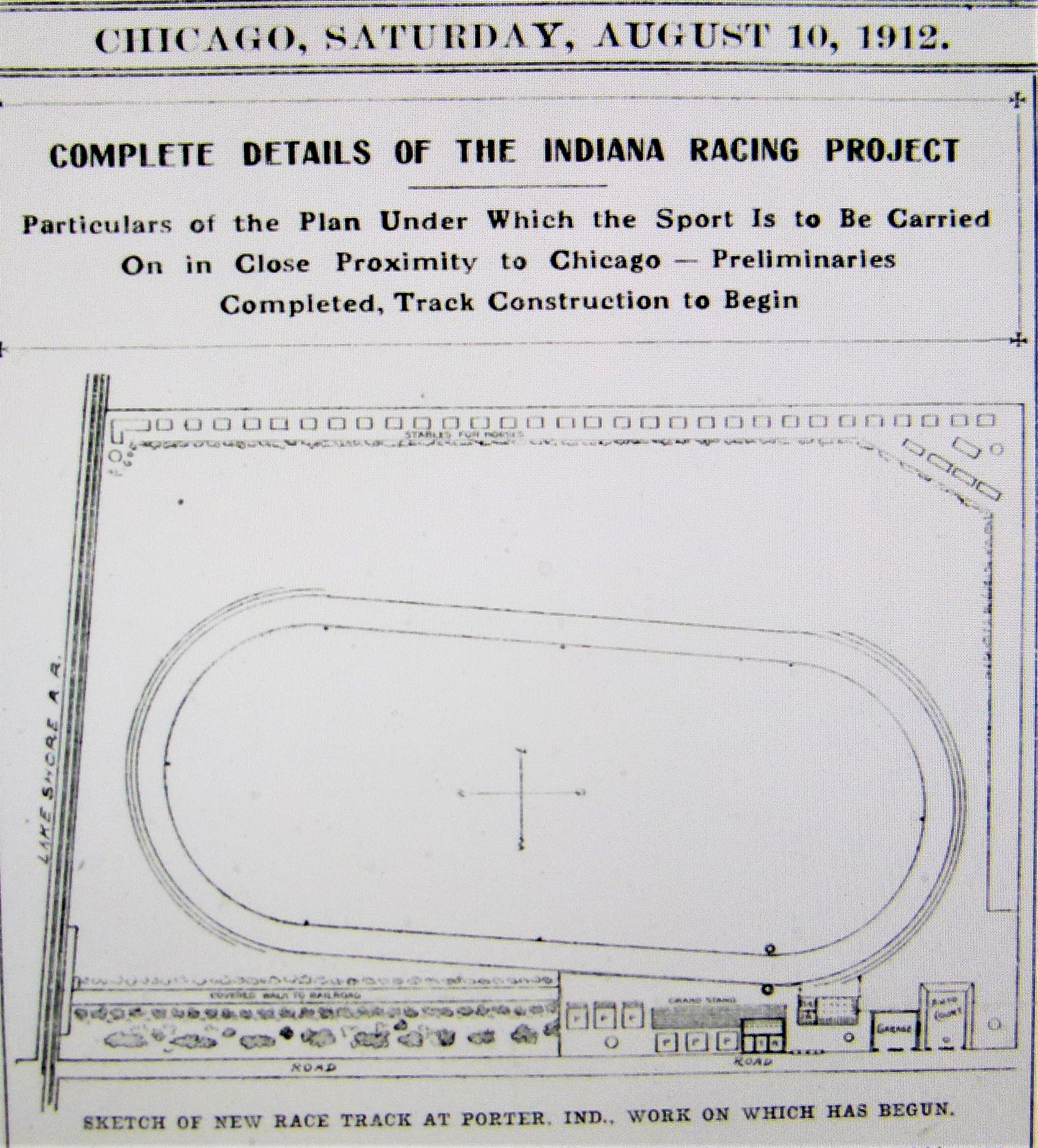
In October 1937, the governor of Rhode Island called out the National Guard and declared martial law at Narragansett Park race track in order to prevent the track from opening for its fall meet. The reason was a political feud between the governor and the track’s owner.
It wasn’t the only time troops had occupied an American racetrack. Twenty-five years earlier, a similar incident erupted in another state, for slightly more prosaic reasons, and with a cast of characters almost as colorful as any in the dime novels popular during that era.
Armanis F. Knotts, an attorney and former state representative, variously described as an aloof pontificator given to bouts of pomposity, headed a group whose intentions were to build a resort in the northwestern corner of Indiana. They called themselves the Racing Foundation Corporation of America (RFCA) and purchased land in Porter County adjacent to several railroad lines.
Their original plans included other facilities, such as tennis courts and a golf course, a spa and mineral baths. They also wanted to build a race track. The track would be leased to an entity known as the Mineral Springs Jockey Club (MSJC).
Doomed to failure from the start
The project was doomed to failure from the start, for the simple reason that gambling wasn’t legal in the state of Indiana. The laws themselves, though, were somewhat convoluted. Curiously, horse racing in the state was allowed.
The Sellers Law, passed by Indiana’s General Assembly in 1885 and named for its sponsor, state senator Emory B. Sellers, decreed that racing could take place for a total of 45 days a year in each county between April 15 and November 15, with meetings lasting no longer than 15 days at a time, with a gap of at least 30 days between each meeting at the same venue.
To circumvent this rule and hold continuous race meetings, the RFCA’s plan was to eventually build two tracks in different towns.
The proposed track received plenty of column inches in the pages of the Daily Racing Form during that summer of 1912, the paper singing the praises of the management team, deeming them “men of means and good standing”. Past performances and charts for racing at Hamilton, Ontario, and Butte, Montana, filled the pages of the Form. There was also racing in Kentucky and Maryland. But it was August – where was Saratoga?
Racing in New York had ceased due to the passage of the Hart-Agnew Law by the New York state legislature in June of 1908. Further legislation passed in 1910 stating that track owners and directors could be held criminally liable for violations of the anti-betting law on their premises led to a complete shutdown as no one wanted to risk imprisonment.
The RFCA went to great lengths to see that their venture went ahead, but, even before the grandstand had been completed, Indiana’s governor ‘got the bit between his teeth’, so to speak, and was determined to find a way to stop racing from happening.
Thomas R. Marshall, who was also the Democratic party nominee for vice-president, made it clear that he would prevent racing at the new venue, while the owners took great pains to reassure him there would be no gambling allowed.
The Mineral Springs Jockey Club’s income would be derived solely from admission fees and sales of food, and this would be used to pay the lease to the RFCA.
Harness racing had flourished in Indiana, taking place at tracks and county fairs throughout the state, and some newspaper accounts “strongly hinted” that the governor may have been intent on protecting harness racing interests.
When the governor turned a blind eye
But was the governor just trying to present a hard-line image as he was running for a national office? He denied this and was quoted in the October 3 Chesterton Tribune as saying: “Just because I am a candidate for office is no reason why I should sit idly by and allow the laws to be broken. Indiana is not going to be the dumping ground for Chicago gamblers ...”
Ah, yes. Chicago, only an hour’s train ride away, where racing had been stopped six years earlier due to rampant crime and corruption.
Gambling was taking place in Indiana, very much illegally, at hotels downstate in a town colorfully named French Lick. The governor seemed to turn a blind eye to this. The reason could have been because the governor was protecting the business interests of a fellow Democrat, one Thomas Taggart, the owner of one of those hotels, who was a member of the Democratic National Committee and had been DNC chairman from 1904 to 1908 – and who was involved in securing the nomination of Woodrow Wilson and Marshall for the Democratic presidential ticket in 1912. As the track readied for its opening, the governor was mainly out of state campaigning.
The Mineral Springs meeting was under a cloud before it even started, both literally and figuratively.

The day racing went ahead
On October 9, the state’s attorney general, Thomas M. Honan, applied for an injunction on behalf of Governor Marshall before Judge Willis C. McMahan to prevent the RFCA from conducting racing at Mineral Springs, alleging the track would be used for gambling through methods intended to evade Indiana gambling laws.
Knotts was confident of an outcome in the track’s favor. He was right, this time. On the 11th the judge refused to grant the temporary injunction.
The track opened on Wednesday, October 16. Six races were held, four sellers, an all-ages handicap and an allowance for 2-year-olds, all run between five and six and a half furlongs. There was a crowd estimated at around 2,500, which, the Form noted, was “in the main masculine, although there was a considerable sprinkling of femininity in the grandstand”.
That same day, the Form’s front page featured this item: a decision in a New York courtroom that could open the door to a revival of racing in New York, with justice Townsend Scudder of the Nassau County supreme court arguing that the owners and directors of a race track couldn’t be held responsible unless they had positive knowledge that bookmaking was taking place at their track.
‘Oral’ betting between individuals
Meanwhile, it was reported that “anyone who wanted to place a bet could do so without a problem” at Mineral Springs, though the Form indicated this consisted of mainly ‘oral’ betting between individuals. On a campaign stop in Chicago, Governor Marshall was confronted by reporters about the situation at Mineral Springs.
Attorney General Honan ordered Sherriff Clayton A. Wood of Porter County, along with his deputies, to investigate. A representative from the attorney general’s office was also on hand.
Deputy C.F. Green told the press that, while he believed people were betting, “it was hard to catch them at it”. Five men were arrested on suspicion of gambling but were soon released due to lack of evidence.
Citing a conflict of interest, Judge McMahan insisted the matter should be heard by another judge. Harry B. Tuthill, of the Lake-LaPorte-Porter Superior Court, was chosen to hear the case.
A hearing was held on the morning of Saturday, October 19, when Attorney General Honan withdrew his application for an injunction due to insufficient evidence.
The National Guard is called in
In the meantime, a ‘sensational’ report appeared in the Chicago papers that the Governor was preparing to call out the militia to prevent racing from going ahead.
The October 22 the Form announced that Tuesdays and Fridays would be ‘Ladies Days’ at Mineral Springs, with women admitted free. The governor had other plans.
That day, troops from the Indiana National Guard were sent to put a stop to racing. With a light drizzle falling, they arrived at the track at 12.40 p.m. under the command of Major George W. Freyermuth, under orders from the governor.
Soldiers were stationed at each of the track’s entrance gates to prevent anyone from entering. Guardsmen turned away patrons who had arrived on special race trains from Chicago. Those who were already there were held for about an hour before they were allowed to leave. The guardsmen refused admission to everyone except for a few newspaper reporters and track officials.
‘The jockeys stopped their mounts a few feet from the bayonets’
When attempts were made to run the first race, the October 24 Chesterton Tribune described the scene this way: “A line of soldiers with bristling bayonets was immediately stretched across the track and as the race horses charged down the track the sight of the guns proved too much for the jockeys and they faltered and stopped their mounts a few feet from the threatening bayonets. The racing, for the day, at least, was over.”
A second company of guardsmen arrived at about three that afternoon, under the command of Captain George Healy. A track employee wrote out an announcement on a blackboard which was placed at the back of the judges’ stand. It read: “Just as soon as executive anarchy is suppressed legal racing will proceed”.
Sherriff Wood arrived at the track. At first he was denied entry but then was allowed in. He asked Major Freyermuth if martial law had been declared and was told it had not.
Knotts spoke to reporters, saying, “We have only started our fight,” and termed the occupation “social anarchy”. Knotts said the track was under ‘martial’ law, but made sure to spell it out for the assembled press: MARSHALL. He then reportedly rushed to the Porter Circuit Court to see Judge McMahan seeking an injunction to force the troops to leave.
Entries for Mineral Springs appeared in the Form for the 23, 24 and 25, though no racing took place.
Arguments were heard on the 24th. Knotts and Peter Crumpacker, attorneys for the RFCA, argued that Indiana law allowed the governor to send out troops “in cases of tumult or mob violence, neither or which were occurring” at the track. They argued that the governor had exceeded his authority in the matter and that, even if gambling had been taking place, it was a matter for the courts to address, not the governor.
Tuthill took the case under advisement. He rendered his decision on the 26th, refusing to grant the injunction to the MSJC on the grounds that he had no right to interfere with the governor’s decision.
He cited a section of the Indiana state constitution stating that the governor may call out the militia in order to execute state laws and that the judiciary had no power to control the governor in discharging those duties. A day earlier, the attorney general had withdrawn his application for a permanent injunction to stop the track from racing as he deemed it was no longer necessary as the militia was doing that very thing.
‘Mounted jackasses’
It was announced on the 26th that the meeting at Mineral Springs had been called off. Knotts assured horsemen that purses would be paid and they would be given sufficient funds to ship their horses elsewhere.
The last company of guardsmen left the track around 2 p.m. on October 28. Only about 30 horses remained on the grounds.
It wasn’t long before there were rumblings in the press that the MSJC planned to resume racing. The governor, in Chicago, was asked his opinion on this news and said it would be up to the attorney general whether or not to try to stop racing.
One day of racing was held, on Saturday, November 2. In an irreverent nod to the governor, one race was called the ‘Tom Marshall Derby’ and featured “mounted jackasses” instead of Thoroughbreds. Only 200 people showed up.
The races were run not for purse money but for gate receipts. Management raced in order to make a point that the governor’s action in calling out the militia had ruined the track’s chances of attracting sufficient crowds. That point was made. The Form only printed a small list of entries instead of the usual full past performances for Mineral Springs.
This defiant notice was posted at the track: “Racing under the Sellers Law will be conducted by this association for forty-five days during the period between June 15 and October 1, 1913.”
A new governor - but the gambling issue continues
Marshall left the office of governor to serve as vice-president under Wilson for two terms, from 1913 until 1921, but the issue of gambling at Mineral Springs continued under the new governor, Samuel Ralston.
On June 5, 1913, Knotts announced that a 15-day meeting would take place beginning on Saturday, June 28. A few days later, that was changed to July 3. Rumors began circulating in the press that the militia would be called out again.
Meanwhile, racing had returned to New York on May 30, with a well-attended meeting at Belmont Park.
A meeting between attorney general Honan and Governor Ralston took place on June 26. It was decided to let the local authorities monitor the racing for any illegal gambling activity.
Racing commenced on Thursday, July 3, as planned. There was considerably less ink given to the opening in the Form than had been the case a year earlier. The day’s fifth race was cancelled due to a lack of runners.
At the start of the meet, fields were short, but attendance was decent and purses were paid out promptly. However, cards were then cut from six to five races a day. With the arrival of more horses, by the 10th they were back up to six races a day. Several people were arrested for gambling in the first couple of days but once more were released due to lack of evidence. The rest of the meeting went ahead without any untoward incidents.
‘Plenty of betting action’
The next meeting opened on schedule on August 21, despite the governor having said he was willing to put a stop to it “at the point of the bayonet if necessary”. The Form reported: “Those who were inclined to make a wager could find plenty of accommodation, but in a quiet way.”
On the 24th, the paper declared: “There was plenty of betting action … the majority of the patrons of the sport combined profit with their pleasure.” Crowds were up and fields were fuller.
On August 26, the governor was informed by one of his agents at the track that “gambling had been openly conducted”. The following evening, the troops were back.
After the day’s racing on the 27th had been completed, two companies of guardsmen occupied the track. The meeting was officially called off on the 28th.
Knotts announced plans to file suit for $50,000 in damages against both the former and present governors for shutting down racing. He met with the governor at the end of September, reiterating his argument that the issue was one for the courts to decide, while attorney general Honan maintained the view that the governor had the right to use military force to uphold the state’s laws.
A small item at the bottom of the front page of the Daily Racing Form on September 2 read: “After a conference with Governor Ralston, Adjutant General McCoy yesterday recalled the Indiana troops from the Porter racetrack. Many horses are still quartered there.”
And that was the end of the Mineral Springs Jockey Club. Except for this footnote:
On September 19, 1917, the grandstand burned to the ground after being struck by lightning.
The same year, the track operators were ordered to pay what was owed to the lumber company. The judge hearing the case was former state senator Emory Sellers, author of the Sellers Law.
Today, racing – and betting – are legal in Indiana. The hotels that once hosted illegal games have been home to modern, opulent casino complexes since 2008. Hoosier Park opened on September 1, 1994, with Thoroughbred racing and now conducts harness racing. Indiana Downs, now Indiana Grand, opened in 2001 and features Thoroughbred racing. Legislation was passed in 2007 allowing casinos at both tracks. How times have changed.
Sources
- A Booming Bust: Horse Racing at Mineral Springs, Steven R. Shook, porterhistory.org, November 8, 2015
- Daily Racing Form archives, various editions, 1912 & 1913
- Governor sent in soldiers to stop Porter races, Nancy Coltun Webster, chicagotribune.com, July 15, 2016
- Indiana Soldiers Seize A Race Track, New York Times, October 23, 1912
- The Battle of Mineral Springs, John Hmurovic, Indiana Magazine of History, June 2014



